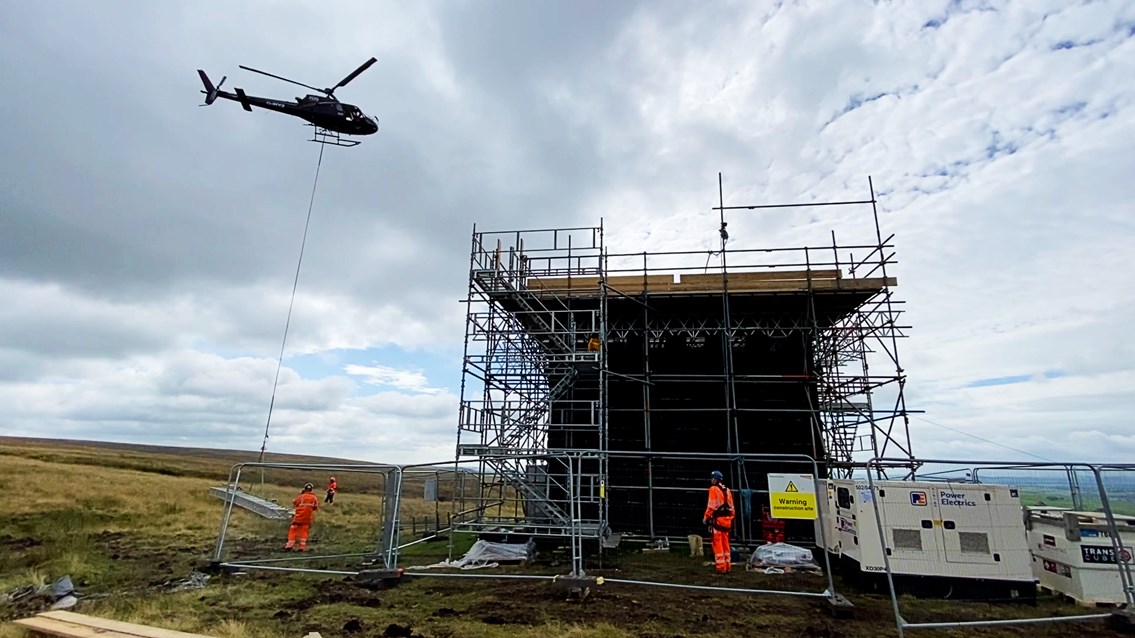Wednesday 22 Sep 2021
Helicopters help railway engineers going 'down under' in the Peak District
- Region & Route:
- North West & Central
- | North West & Central: North West
In a rare move construction materials have been airlifted into position by helicopter for essential repairs to a ventilation shaft in one of the deepest railway tunnels in Britain.
Network Rail has completed essential maintenance to Cowburn Tunnel* on the Hope Valley line as part of a major £800,000 Great North Rail Project investment.
The tunnel between Edale and Chinley goes underneath key peaks near Kinder Scout and Mam Tor in the Peak District National Park.
Because of its remote location, helicopter pilots were drafted in to transport vital materials and components for work on the tunnel’s ventilation shaft.
Vertically dug 241 metres into the hillside, it’s one of the deepest railway ventilation shafts in the country**.
If it were a building it would be taller than Canary Wharf in London.
But for nearly 130 years, as well as providing air to the tunnel more than 250 metres below, the ventilation shaft has also inadvertently acted like a huge drainpipe.
When rain falls on the land above it seeps through the soil before making its way through the ventilation shaft’s brickwork, cascading like a massive shower head into the tunnel and tracks below.
To solve this Network Rail engineers has installed a sophisticated system of drainage pipes to collect the water in a controlled way so it can be diverted into drains in the tunnel itself.
This will protect the 127-year-old brickwork and reduce the risk of passengers and freight on the busy Hope Valley line from future delays caused by the water leaks.
Dennis McGonnell, Network Rail works delivery manager, said: “It’s a huge privilege to keep heritage structures like Cowburn Tunnel in good condition for rail passengers and freight and it’s amazing to see up close the quality of the Victorians’ workmanship.
“We work on a lot of structures in remote locations but working in a tunnel this deep and using helicopters to get materials to site is rare. It makes you realise what an amazing feat of engineering building this tunnel and ventilation shaft was all that time ago without the modern machinery we have today!”
For the new pipes and water collecting devices to be installed, engineers built a temporary lift platform to work from using winches and pulleys.
Network Rail teams were lowered into the ventilation shaft in a custom-built cradle, similar to their Victorian predecessors who excavated the shaft 127 years before them.
Doing the work this way meant trains could still run in the tunnel below without disrupting passenger or freight services.
Drainage improvements at track level could only take place on Saturday nights when trains weren't running.
The work started in August 2021 and finished this week.
For more information on how Network Rail maintains historic structures visit: www.networkrail.co.uk/who-we-are/our-history/working-with-railway-heritage/
Notes to Editors
*Cowburn Tunnel facts
The tunnel was engineered by the Midland Railway, under Colborne, part of a 1,700-foot (518 m) moorland between Kinder Scout and Rushup Edge.
Tunneling also started at the other end near Chapel-en-le-Frith and the breakthrough between the two sections was made on 18 July 1891.
The lining out of the tunnel and laying of the rails was completed by March 1893.
**Ventilation shaft facts
A single ventilation shaft, accessible via the moorland north-west of Mam Tor, is 791 feet (241 m) deep, making it one of the deepest railway ventilation shafts in the country.
The shaft was constructed in 1894 over the course of two years.
Men lived on the rough exposed moorlands to dig the shafts without any modern machinery and were lowered into the shaft using a winch mechanism.
102 men worked eight-hour shifts day and night to excavate, mason and brick the shaft.
The shaft opens into a large chamber offset from the double track railway lines.
With a ceiling more than 10 metres high the chamber has become known as ‘the Cathedral’ because of its pristine stonework.
It’s a mystery to Network Rail teams today why such precision was used to build this chamber which is usually in the pitch black and rarely seen by anyone.
The shaft was eventually completed on 16 March 1896.
On the moorlands above, the ventilation shaft remains open but it is protected by a large brick enclosure with turrets which make it look like a castle.
Contact information
Passengers / community members
Network Rail national helpline
03457 11 41 41
Latest travel advice
Please visit National Rail Enquiries
Journalists
Network Rail press office - North West & Central Region
0330 854 0100
NWCmediarelations@networkrail.co.uk
About Network Rail
We own, operate and develop Britain's railway infrastructure; that's 20,000 miles of track, 30,000 bridges, tunnels and viaducts and the thousands of signals, level crossings and stations. We run 20 of the UK's largest stations while all the others, over 2,500, are run by the country's train operating companies.
Usually, there are almost five million journeys made in the UK and over 600 freight trains run on the network. People depend on Britain's railway for their daily commute, to visit friends and loved ones and to get them home safe every day. Our role is to deliver a safe and reliable railway, so we carefully manage and deliver thousands of projects every year that form part of the multi-billion pound Railway Upgrade Plan, to grow and expand the nation's railway network to respond to the tremendous growth and demand the railway has experienced - a doubling of passenger journeys over the past 20 years.
Follow us on Twitter: @networkrail
Visit our online newsroom: www.networkrailmediacentre.co.uk


